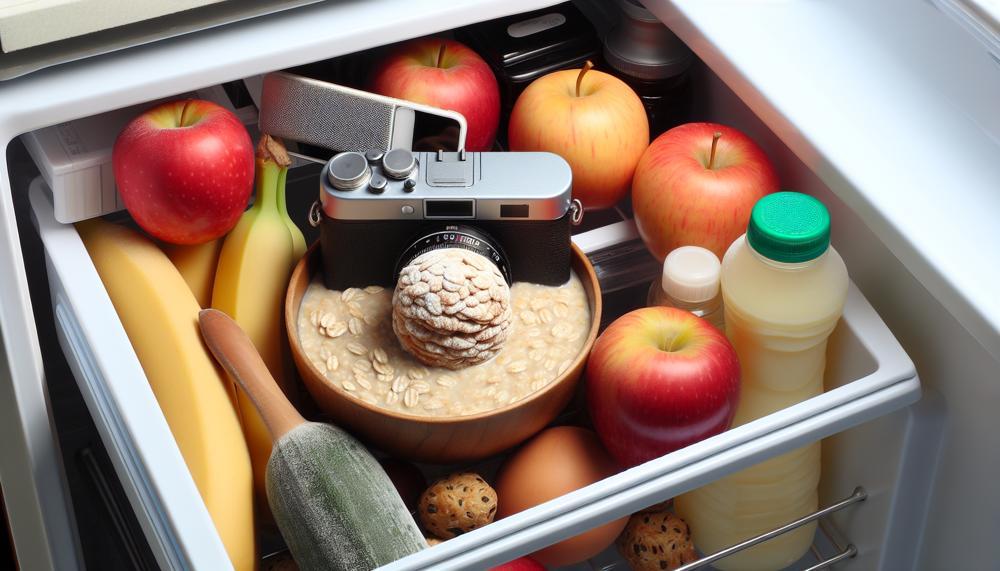When it comes to breakfast options, oatmeal is a popular choice for its nutritional benefits and satisfying taste. But did you know that you can actually save oatmeal in the fridge? By refrigerating oatmeal, you can extend its shelf life, making it a convenient option for busy individuals who want to enjoy the health benefits of oatmeal throughout the week.
So, can you save oatmeal in the fridge?
Yes, you can store oatmeal in the fridge for up to five days in an airtight container. For best results, let the oatmeal cool to room temperature before putting it in the fridge. Putting hot oatmeal in the fridge can cause condensation, which can affect the texture. You should also label the container with the date it was prepared to help you keep track of freshness.
Oatmeal can also be frozen for up to three months. You can freeze oatmeal before or after baking.
You should check the quality of the oats frequently to ensure they have not spoiled. After five days, the oatmeal may not be safe to eat due to bacteria.
Oats stored in a non-porous airtight container will last longer. Paper packaging can allow airborne yeast and humidity to enter the bag and spoil the product. While affected oats will still look OK, their sour flavor will convince you otherwise.
Contents
- 1 How to Save Oatmeal in the Fridge
- 2 Tips for Storing Oatmeal in the Fridge
- 3 Factors that May Cause Oatmeal to Go Bad
- 4 Signs of Spoiled Oatmeal
- 5 Can You Freeze Oatmeal?
- 6 How Long Can Oatmeal be Stored in the Fridge?
- 7 Other Ways to Enjoy Oatmeal
- 8 Benefits of Saving Oatmeal in the Fridge
- 9 Best Practices for Storing Oatmeal
- 10 Is Storing Oatmeal in the Fridge Safe?
- 11 Conclusion
Key Takeaways:
- Refrigerating oatmeal can help keep it fresh and ready to eat for several days.
- Store oatmeal in airtight containers or individual portions to prevent spoilage.
- Use clean and dry containers to avoid moisture buildup and maintain the quality of the oatmeal.
- Consider freezing oatmeal for long-term storage, dividing it into portion-sized containers or freezer bags.
- Regularly check for signs of spoilage, such as unusual odor, visible mold, or off-putting taste and texture.
How to Save Oatmeal in the Fridge
To extend the shelf life of your oatmeal and keep it fresh for longer, storing it in the fridge is an excellent option. Follow these simple steps to save your oatmeal and ensure it stays delicious:
- Cook a large batch of oatmeal according to your preferred recipe.
- Allow the oatmeal to cool completely.
- Transfer the oatmeal to an airtight container or individual portion-sized containers.
- Place the container(s) in the refrigerator.
By storing oatmeal in the fridge, you can prevent it from going bad and extend its shelf life significantly. This method also allows for easy reheating whenever you’re ready to enjoy a nutritious and satisfying meal.
Tips for Storing Oatmeal in the Fridge
When it comes to storing oatmeal in the fridge, following a few simple tips can help prevent spoilage and ensure that your oatmeal stays fresh and delicious for longer periods. Here are some key strategies to keep in mind:
Use Clean and Dry Containers
Moisture buildup can lead to spoilage and the growth of mold or bacteria in your stored oatmeal. To prevent this, make sure to use clean and dry containers before transferring your oatmeal to the fridge. This will help maintain its quality and prevent any unwanted odors or flavors.
Store in the Main Body of the Fridge
The main body of the fridge generally provides a consistent and cooler temperature, ideal for preserving the freshness of oatmeal. Avoid storing oatmeal in the fridge door, as temperatures in this area tend to fluctuate more frequently due to the opening and closing of the door.
Consider Freezing Individual Portions
If you want to store oatmeal for an extended period, freezing individual portions can be a great option. This allows you to conveniently thaw and reheat only the amount you need without compromising the quality of the remaining oatmeal. Use freezer-safe containers or resealable bags to ensure the oatmeal is well-protected from freezer burn.
| Storing Tips | Benefits |
|---|---|
| Use clean and dry containers | Prevents moisture buildup |
| Store in the main body of the fridge | Maintains consistent temperature |
| Consider freezing individual portions | Extended storage life |
Factors that May Cause Oatmeal to Go Bad
In order to understand why oatmeal may spoil, it’s important to consider a few key factors. Unprocessed oats and those stored in paper packaging are more prone to spoilage due to exposure to yeast and humidity. Additionally, oatmeal that hasn’t been commercially processed or contains unstabilized oils can also be at risk of going bad. Over time, oats may undergo slight changes in flavor, color, or nutritional value past their “best by” date.
Factors Leading to Oatmeal Spoilage:
- Unprocessed oats
- Paper packaging
- Commercial processing
- Unstabilized oils
When oats are unprocessed or stored in paper packaging, they are more susceptible to spoilage due to the presence of yeast and the absorption of humidity. The lack of commercial processing or unstabilized oils in oatmeal can also contribute to spoilage. These factors can affect the overall quality and safety of the oatmeal, making it important to assess its condition before consumption.
Despite these potential factors, it’s important to note that oatmeal can still be safely consumed even if it has slight changes in flavor, color, or nutritional value past its “best by” date. However, it’s essential to check for signs of spoilage and use discretion in determining whether the oatmeal is still suitable for consumption.
| Factors that May Cause Oatmeal to Go Bad | Effects on Oatmeal |
|---|---|
| Unprocessed oats |
|
| Paper packaging |
|
| Commercial processing |
|
| Unstabilized oils |
|
Understanding the reasons for oatmeal spoilage can help you make informed decisions about its consumption and storage. By being aware of these factors, you can take steps to ensure the oatmeal remains fresh and safe for consumption.
Signs of Spoiled Oatmeal
It’s important to recognize signs of spoilage in oatmeal. By identifying spoiled oatmeal, you can avoid consuming it and reduce the risk of foodborne illnesses. Here are the key indicators to look out for:
- Unusual Odor: Discard oatmeal if it emits a foul or sour smell. This could be an indication of bacterial growth or rancidity.
- Visible Mold: If you notice any mold growth on the oatmeal, it’s best to discard it immediately. Mold can produce harmful toxins that are dangerous to consume.
- Off-Putting Taste: Taste a small portion of the oatmeal before consuming. If it has an off taste or rancid flavor, do not consume it.
- Texture Changes: Spoiled oatmeal may become slimy or grainy in texture. If the oatmeal feels slimy or has an unusual grainy texture, it is no longer suitable for consumption.
Expert Insight: “Spoiled oatmeal can pose health risks if consumed. Trust your senses and discard any oatmeal that shows signs of odor, mold, off-putting taste, or texture changes.” – Dr. Samantha Carter, Food Safety Specialist
By being vigilant and recognizing these signs of spoilage, you can ensure the oatmeal you consume is safe and enjoy its nutritional benefits without any risks to your health.
| Signs of Spoiled Oatmeal | Action |
|---|---|
| Unusual Odor | Discard immediately |
| Visible Mold | Discard immediately |
| Off-Putting Taste | Do not consume |
| Texture Changes | Do not consume |
Can You Freeze Oatmeal?

Yes, oatmeal can be frozen for long-term storage. Freezing oatmeal is a convenient way to preserve it and extend its shelf life. By freezing individual portions, you can easily thaw and reheat them whenever you need a quick and wholesome meal. Here are some important steps to follow when freezing oatmeal:
- Divide into portions: Before freezing, divide the cooked oatmeal into individual portions. This makes it easier to thaw and reheat only what you need at a time, minimizing food waste.
- Use airtight containers or freezer bags: To prevent freezer burn and preserve the taste and texture of the oatmeal, use airtight containers or freezer bags. Make sure to remove any excess air before sealing to maintain freshness.
- Label and date: It’s essential to label the containers or bags with the date of freezing to keep track of storage times. This helps ensure that you consume the oatmeal within the recommended timeframe for best quality.
- Freeze at 0°F (-18°C): Place the oatmeal in the freezer and set the temperature to 0°F (-18°C) or lower. Freezing at this temperature helps maintain the texture and quality of the oatmeal.
To thaw frozen oatmeal, you have a couple of options:
- Refrigerator thawing: The safest method is to transfer the frozen oatmeal to the refrigerator and let it thaw overnight. This gradual thawing ensures even defrosting and maintains the oatmeal’s quality.
- Microwave defrost function: If you’re short on time, you can use the defrost function on your microwave. Follow the manufacturer’s instructions for thawing frozen oatmeal to prevent overcooking or uneven heating.
Once the oatmeal is thawed, you can reheat it in the microwave or on the stovetop. Enjoy your frozen oatmeal with your favorite toppings and flavors for a nutritious and convenient meal!
How Long Can Oatmeal be Stored in the Fridge?
Refrigerated oatmeal can typically be stored for several days, up to a week, if properly stored in airtight containers. It’s important to check for signs of spoilage before consuming refrigerated oatmeal to ensure it is still safe to eat.
Oatmeal that has been refrigerated can retain its freshness and quality, allowing you to enjoy it over multiple servings. By storing it in airtight containers, you can prevent moisture and odors from affecting the oatmeal, preserving its taste and texture.
When refrigerating oatmeal, it is crucial to pay attention to any signs that it may have spoiled. This ensures that you are not consuming oatmeal that is no longer safe to eat, reducing the risk of foodborne illnesses.
“Refrigerated oatmeal can be a convenient and healthy breakfast option, but it’s important to be mindful of its shelf life. By properly storing and regularly checking for signs of spoilage, you can ensure that the oatmeal remains safe to consume.”
– Dr. Emily Roberts, Nutritionist
When refrigerating oatmeal, here are some key signs to watch out for:
- Unusual odor: If the oatmeal has an off smell, such as a foul or sour odor, it may indicate spoilage.
- Mold growth: Visible mold on the oatmeal is a clear sign of spoilage and should be discarded immediately.
- Off-putting taste or texture: If the oatmeal tastes rancid or has a slimy or grainy texture, it is best to avoid consuming it.
Regularly check the oatmeal for these signs before eating it, even if it falls within the recommended storage time. It’s better to be cautious and discard potentially spoiled oatmeal to ensure your health and safety.
Shelf Life of Refrigerated Oatmeal
| Storage Duration | Condition | Suggested Actions |
|---|---|---|
| Up to 3 days | Oatmeal stored in airtight containers in the coldest part of the fridge | Check for signs of spoilage before consuming |
| 3-7 days | Oatmeal stored in airtight containers in the coldest part of the fridge | Check for signs of spoilage before consuming |
| More than 7 days | Oatmeal stored in airtight containers in the coldest part of the fridge | Discard to avoid potential foodborne illnesses |
Other Ways to Enjoy Oatmeal
If you’re looking to add some variety to your oatmeal, try experimenting with different toppings and variations. By incorporating different flavors and textures, you can transform a simple bowl of oatmeal into a delightful and satisfying meal. Here are some creative ideas to inspire you:
Fruit and Nut Medley
Create a delightful combination of flavors and textures by adding fresh fruits and nuts to your oatmeal. Try topping your oatmeal with sliced bananas, chopped walnuts, and a drizzle of honey.
The sweetness of the bananas, the crunch of the walnuts, and the natural sweetness of honey will elevate your oatmeal to a whole new level.
Savory Delights
Don’t limit yourself to sweet toppings – oatmeal can also be a delicious savory meal! Add some unexpected flavors by topping your oatmeal with savory ingredients such as cheddar cheese, a fried egg, and fresh scallions.
The creamy cheese, the rich yolk from the egg, and the freshness of the scallions create a unique and satisfying combination.
Indulgent Treats
For those days when you’re craving something indulgent, try adding some treats to your oatmeal. Consider mixing in a handful of mixed nuts and drizzling maple syrup on top.
The combination of crunchy nuts and the rich sweetness of maple syrup will turn your oatmeal into a decadent dessert-like treat.
Yogurt Paradise
Add a creamy and tangy twist to your oatmeal by adding Greek yogurt and your favorite jam. The creamy yogurt adds richness and depth to the oatmeal, while the jam provides bursts of fruity flavor.
It’s a delightful combination that will make your breakfast feel like a special occasion.
Classic Combos
If you’re a fan of classic flavor combinations, consider mixing almond butter and jelly into your oatmeal. The nuttiness of the almond butter and the sweetness of the jelly create a nostalgic and comforting flavor profile.
Alternatively, you can’t go wrong with the timeless combination of brown sugar and blueberries. The sweetness of the brown sugar complements the natural tartness of the blueberries, resulting in a harmonious pairing.
These are just a few ideas to inspire you to get creative with your oatmeal. Don’t be afraid to try new combinations and experiment with different flavors. With the right toppings and variations, oatmeal can be a delicious and versatile meal that you’ll look forward to enjoying every morning.
Benefits of Saving Oatmeal in the Fridge
Refrigerating oatmeal offers several benefits that can enhance your meal planning and reduce food waste. By storing oatmeal in the fridge, you can enjoy convenient and ready-to-eat meals throughout the week while extending its shelf life.
One of the key advantages of refrigerating oatmeal is the ability to prepare it in advance. By cooking a large batch of oatmeal and refrigerating it, you can save time during busy mornings or when you need a quick meal. Simply reheat the refrigerated oatmeal, and it’s ready to be enjoyed, making it a convenient option for individuals with hectic schedules.
In addition to the convenience factor, refrigerating oatmeal helps to prevent waste. Oatmeal that is left at room temperature can quickly spoil, resulting in the need to discard it. By refrigerating oatmeal, you can extend its shelf life and significantly reduce the chances of it going bad. This not only saves you money but also contributes to a more sustainable approach to food consumption.
When properly stored in airtight containers, refrigerated oatmeal can remain fresh and safe to eat for several days. This means you can prepare larger batches, reducing the need for daily cooking. Planning your meals ahead of time and refrigerating oatmeal allows you to have healthy, homemade meals readily available, promoting a balanced and nutritious diet.
Overall, the benefits of refrigerating oatmeal include convenient meal planning and preparation, reduced food waste, and extended shelf life. By incorporating this simple storage technique into your routine, you can enjoy the many advantages of refrigerated oatmeal while ensuring you always have a delicious and nutrient-packed meal on hand.
Best Practices for Storing Oatmeal
When it comes to storing oatmeal, following proper practices can help ensure its freshness and prolong its shelf life. Here are some essential tips for storing oatmeal:
- Use airtight containers or resealable bags: To prevent moisture and air from reaching the oatmeal, store it in airtight containers or resealable bags. This will help maintain its quality and prevent it from becoming stale.
- Store in the coolest part of the fridge: Oatmeal should be stored in the coolest section of the refrigerator, typically in the main body. Avoid storing it in the refrigerator door, as temperatures in this area tend to fluctuate, compromising the oatmeal’s freshness.
- Keep away from strong-smelling foods: Oatmeal can absorb odors from other strong-smelling foods in the refrigerator. To prevent flavor transfer, store it away from foods like fish, garlic, onions, or strong cheeses.
- Regularly check for signs of spoilage: It’s important to regularly inspect the oatmeal for any signs of spoilage. Look out for unusual odors, mold growth, or changes in texture. If you notice any of these signs, discard the oatmeal to avoid consuming spoiled food.
Following these best practices will help ensure that your oatmeal stays fresh and ready to enjoy for an extended period. By creating the optimal storage environment, you can avoid waste and maintain the quality of your oatmeal for longer.
| Storage Tips | Importance |
|---|---|
| Use airtight containers or resealable bags | Prevents moisture and air exposure, maintaining freshness |
| Store in the coolest part of the fridge | Ensures optimal temperature for oatmeal storage |
| Keep away from strong-smelling foods | Prevents flavor transfer and unpleasant taste |
| Regularly check for signs of spoilage | Avoids consumption of spoiled oatmeal |
Is Storing Oatmeal in the Fridge Safe?
When it comes to the safety of refrigerated oatmeal, following proper storage practices is key. Storing oatmeal in the fridge is generally safe as long as certain precautions are taken to prevent spoilage and ensure food safety.
Oatmeal, like any food, can be susceptible to bacteria growth if not stored correctly. It’s important to regularly check for signs of spoilage and discard any oatmeal that shows visible signs of mold, an unusual odor, or an off-putting taste or texture.
Here are some guidelines to help ensure the safety of refrigerated oatmeal:
- Use clean and dry containers: Moisture can contribute to the growth of bacteria. Make sure to use clean and dry containers to store your oatmeal in the fridge. Airtight containers are ideal for preventing moisture buildup and maintaining freshness.
- Store in the coolest part of the fridge: Oatmeal should be stored in the main body of the refrigerator, as temperatures in the door can fluctuate more. This helps to maintain a consistent and cool temperature, reducing the risk of bacterial growth.
- Check for signs of spoilage: Before consuming refrigerated oatmeal, always check for signs of spoilage such as an unusual odor, visible mold, or an off-putting taste or texture. If any of these signs are present, it’s best to discard the oatmeal to ensure food safety.
By following these guidelines, you can enjoy the convenience of refrigerated oatmeal while prioritizing food safety. Regularly inspecting your oatmeal and taking the necessary measures to prevent spoilage will help ensure that your stored oatmeal is safe to consume.
Conclusion
Refrigerating oatmeal is an excellent way to prolong its shelf life and enjoy the convenience of quick and easy meals throughout the week. By implementing proper storage practices and being mindful of signs of spoilage, you can safely store oatmeal in the fridge for several days, ensuring it remains fresh and ready to eat whenever you need it.
When refrigerating oatmeal, it’s important to transfer it to airtight containers or individual portions to prevent moisture buildup and maintain its quality. Storing oatmeal in the main body of the refrigerator, away from temperature fluctuations in the door, further enhances its longevity.
By simply refrigerating oatmeal, you can extend its shelf life and reduce the chances of it going bad. This not only saves you money by minimizing food waste but also offers the convenience of having a nutritious and satisfying meal readily available, even on your busiest days. So, start refrigerating your oatmeal today and enjoy the benefits of this simple yet effective storage method.
Source Links
- https://www.bonappetit.com/test-kitchen/cooking-tips/article/oatmeal
- https://www.simplyrecipes.com/how-to-store-oats-7480457
- https://www.tastingtable.com/1497627/how-long-store-leftover-oatmeal-fridge-freezer/




